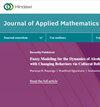贾第虫病传播动态数学模型与带菌者存在时的控制策略
IF 1.3
Q2 MATHEMATICS, APPLIED
引用次数: 0
摘要
贾第虫病是世界卫生组织认定的被忽视的人畜共患病之一,由十二指肠贾第虫引起。这种疾病对人类和其他生物造成的危害被忽视。本文建立了一个关于贾第虫病传播的数学模型,该模型考虑了疾病携带者和控制措施,如筛查、治疗和人周围环境的卫生。在评估中,利用最先进的新一代矩阵确定了用于分析平衡点局部稳定性的基本繁殖数 R 0,同时利用梅兹勒常数推测来说明无疾病平衡点的整体稳定性是否充分。此外,还使用了 Lyapunov 函数来研究地方病平衡点的稳定性。参数评估采用归一化敏感度指数法,以探索对疾病紊乱传播成分有重大影响的极限。结果显示,招募率是对繁殖数量最敏感的限制。环境与人的交互作用参数是社区中传播贾第虫病的第二大影响因素。同样,结果表明,带菌者在随后的贾第虫病发病率中发挥着预期作用;忽视带菌者可能会危及控制疫情的努力。此外,模型的数学再现表明,三种干预措施的混合使用会从根本上影响对贾第虫病的控制。因此,我们建议在流行地区同时实施这些策略,以有效阻止贾第虫病在人类中的传播。本文章由计算机程序翻译,如有差异,请以英文原文为准。
Mathematical Modeling of Giardiasis Transmission Dynamics with Control Strategies in the Presence of Carriers
Giardiasis is among the ignored zoonotic illnesses accorded by the World Health Organization that is caused by Giardia duodenalis. The disease is ignored regardless of the harm it causes to people and other creatures. In this paper, a mathematical model for giardiasis illness transmission is formed, which considers sickness carriers and control measures such as screening, treatment, and sanitation of the environment around people. In the assessment, the basic reproduction number,
R
0
, which is used for analyzing the local stability of the equilibria is determined using the state-of-the-art next-generation matrix, while the Metzler constancy speculation is used to show the overall adequacy of the global stability of the equilibrium point free from the disease. In addition, a Lyapunov function has been used to study the stability of the endemic equilibrium point. The assessment of parameters is performed to explore the limits that significantly influence the transmission components of the disease disorders using the normalizing sensitivity index method. The result revealed that the recruitment rate is the most sensitive limit to the reproduction number. The environment-human interaction parameter is the second influential factor in the transmission of giardiasis in the community. In the same manner, the outcomes recommend that carriers assume an expected part in the rate of giardiasis subsequently; disregarding them could risk endeavors to control the pestilence. Besides, the mathematical recreation of the model shows that a mix of each of the three interventions fundamentally affects the control of giardiasis. In this way, we advise implementing the strategies simultaneously in endemic areas to effectively stop the spread of the giardiasis disease in humans.
求助全文
通过发布文献求助,成功后即可免费获取论文全文。
去求助
来源期刊

Journal of Applied Mathematics
MATHEMATICS, APPLIED-
CiteScore
2.70
自引率
0.00%
发文量
58
审稿时长
3.2 months
期刊介绍:
Journal of Applied Mathematics is a refereed journal devoted to the publication of original research papers and review articles in all areas of applied, computational, and industrial mathematics.
 求助内容:
求助内容: 应助结果提醒方式:
应助结果提醒方式:


